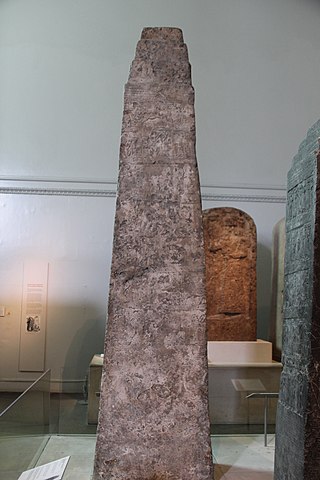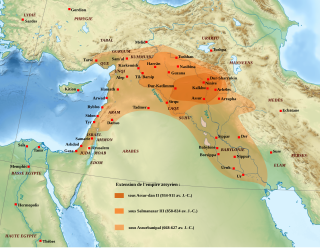Related Research Articles
The 8th century BC started the first day of 800 BC and ended the last day of 701 BC. The 8th century BC was a period of great change for several historically significant civilizations. In Egypt, the 23rd and 24th dynasties lead to rule from Kingdom of Kush in the 25th Dynasty. The Neo-Assyrian Empire reaches the peak of its power, conquering the Kingdom of Israel as well as nearby countries.
The 10th century BC comprises the years from 1000 BC to 901 BC. This period followed the Late Bronze Age collapse in the Near East, and the century saw the Early Iron Age take hold there. The Greek Dark Ages which had come about in 1200 BC continued. The Neo-Assyrian Empire is established towards the end of the 10th century BC. In the Iron Age in India, the Vedic period is ongoing. In China, the Zhou dynasty is in power. Bronze Age Europe continued with Urnfield culture. Japan was inhabited by an evolving hunter-gatherer society during the Jōmon period.

Tiglath-Pileser III was the king of the Neo-Assyrian Empire from 745 BC to his death in 727. One of the most prominent and historically significant Assyrian kings, Tiglath-Pileser ended a period of Assyrian stagnation, introduced numerous political and military reforms and more than doubled the lands under Assyrian control. Because of the massive expansion and centralization of Assyrian territory and establishment of a standing army, some researchers consider Tiglath-Pileser's reign to mark the true transition of Assyria into an empire. The reforms and methods of control introduced under Tiglath-Pileser laid the groundwork for policies enacted not only by later Assyrian kings but also by later empires for millennia after his death.
Salmānu-ašarēd II, inscribed mdSILIM-ma-nu-MAŠ/SAG, meaning " Being peaceful is foremost," was the king of Assyria 1030–1019 BC, the 93rd to appear on the Khorsabad copy of the Assyrian Kinglist, although he has been apparently carelessly omitted altogether on the Nassouhi copy.
Shalmaneser IV was the king of the Neo-Assyrian Empire from 783 BC to his death in 773 BC. Shalmaneser was the son and successor of his predecessor, Adad-nirari III, and ruled during a period of Assyrian decline from which few sources survive. As such his reign, other than broad political developments, is poorly known. Shalmaneser's time was marked both by an increase in the power held by Assyrian officials relative to that of the king and Assyria's enemies growing increasingly powerful. Most of Shalmaneser's military efforts were spent warring against the Kingdom of Urartu in the north, which during this time was reaching the peak of its power.
Ashur-nirari V was the king of the Neo-Assyrian Empire from 755 BC to his death in 745 BC. Ashur-nirari was a son of Adad-nirari III and succeeded his brother Ashur-dan III as king. He ruled during a period of Assyrian decline from which few sources survive. As such his reign, other than broad political developments, is poorly known.
Ashur-dan III was the king of the Neo-Assyrian Empire from 773 BC to his death in 755 BC. Ashur-dan was a son of Adad-nirari III and succeeded his brother Shalmaneser IV as king. He ruled during a period of Assyrian decline from which few sources survive. As such his reign, other than broad political developments, is poorly known. At this time, the Assyrian officials were becoming increasingly powerful relative to the king and at the same time, Assyria's enemies were growing more dangerous. Ashur-dan's reign was a particularly difficult one as he was faced with two outbreaks of plague and five of his eighteen years as king were devoted to putting down revolts.
Adad-nīrārī II reigned from 911 BCE to 891 BCE. He was the first King of Assyria in the Neo-Assyrian empire. He instigated the first renewed period of major expansion following that of the Middle Assyrian Empire which had begun in 1365 BCE under Ashur-uballit I and ended after the death of Ashur-bel-kala in 1053 BCE.

Aššur-nāṣir-apli I, inscribed maš-šur-PAB-A, “the god Aššur is the protector of the heir,” was the king of Assyria, 1049–1031 BC, and the 92nd to appear on the Assyrian Kinglist. He was the son and successor of Šamši-Adad IV, and he ruled for 19 years during a troubled period of Assyrian history, marked by famine and war with nomads from the deserts to the west. He is best known for his penitential prayer to Ištar of Nineveh.

Aššūr-reš-iši II, inscribed maš-šur-SAG-i-ši, meaning "(the god) Aššur has lifted my head," was the king of Assyria, 971–967 BC, the 96th to be listed on the Assyrian Kinglist. His short five-year reign is rather poorly attested and somewhat overshadowed by the lengthy reigns of his predecessor, Aššur-rabi II, and successor, Tukultī-apil-Ešarra II.
Aššur-rabi II, inscribed maš-šur-GAL-bi, "(the god) Aššur is great," was king of Assyria 1012–972 BC. Despite his lengthy reign, one of the longest of the Assyrian monarchs, his tenure seems to have been an unhappy one judging by the scanty and laconic references to his setbacks from later sources.
Aššur-nērārī IV, inscribed maš-šur-ERIM.GABA, "(the god) Aššur is my help," was the king of Assyria, the 94th to appear on the Assyrian Kinglist, ruling 1019/18–1013 BC. His short six-year reign was marked by confusion and a dearth of contemporary inscriptions.
Arik-den-ili, inscribed mGÍD-DI-DINGIR, “long-lasting is the judgment of god,” was King of Assyria c. 1317–1306 BC, ruling the Middle Assyrian Empire. He succeeded Enlil-nirari, his father, and was to rule for twelve years and inaugurate the tradition of annual military campaigns against Assyria's neighbors.

The Neo-Assyrian Empire was the fourth and penultimate stage of ancient Assyrian history. Beginning with the accession of Adad-nirari II in 911 BC, the Neo-Assyrian Empire grew to dominate the ancient Near East throughout much of the 8th and 7th centuries BC, becoming the largest empire in history up to that point. Because of its geopolitical dominance and ideology based in world domination, the Neo-Assyrian Empire is by many researchers regarded to have been the first world empire in history. It influenced other empires of the ancient world culturally, governmentally, and militarily, including the Babylonians, the Achaemenids, and the Seleucids. At its height, the empire was the strongest military power in the world and ruled over all of Mesopotamia, the Levant and Egypt, as well as parts of Anatolia, Arabia and modern-day Iran and Armenia.

The Middle Assyrian Empire was the third stage of Assyrian history, covering the history of Assyria from the accession of Ashur-uballit I c. 1365 BC and the rise of Assyria as a territorial kingdom to the death of Ashur-dan II in 912 BC. The Middle Assyrian Empire was Assyria's first true period of ascendancy as an empire, although Assyrian kings had existed from perhaps as early as the 25th century BC, and from the 21st century BC Assyria had controlled trading colonies in Anatolia and had economic and military influence in Southern Mesopotamia, and from the late 19th century BC had been an integral part of the "Empire of Shamsi-Adad", sometimes called the Old Assyrian Empire. Though the empire experienced successive periods of expansion and decline, it remained the dominant power of Mesopotamia and often the entirety of West Asia throughout the period. In terms of Assyrian history, the Middle Assyrian period was marked by important social, political and religious developments, including the rising prominence of both the Assyrian king and the Assyrian national deity Ashur.

Adad-šuma-uṣur, inscribed dIM-MU-ŠEŠ, meaning "O Adad, protect the name!," and dated very tentatively c. 1216–1187 BC, was the 32nd king of the 3rd or Kassite dynasty of Babylon and the country contemporarily known as Karduniaš. His name was wholly Babylonian and not uncommon, as for example the later Assyrian King Esarhaddon had a personal exorcist, or ašipu, with the same name who was unlikely to have been related. He is best known for his rude letter to Aššur-nirari III, the most complete part of which is quoted below, and was enthroned following a revolt in the south of Mesopotamia when the north was still occupied by the forces of Assyria, and he may not have assumed authority throughout the country until around the 25th year of his 30-year reign, although the exact sequence of events and chronology remains disputed.
Bāba-aḫa-iddina, typically inscribed mdBA.Ú-PAB-AŠ "Bau has given me a brother,” ca. 812 BC, was the 9th king of the Dynasty of E, a mixed dynasty of kings of Babylon, but probably for less than a year. He briefly succeeded Marduk-balāssu-iqbi, who had been deposed by the Assyrians, a fate he was to share.

The timeline of ancient Assyria can be broken down into three main eras: the Old Assyrian period, Middle Assyrian Empire, and Neo-Assyrian Empire. Modern scholars typically also recognize an Early period preceding the Old Assyrian period and a post-imperial period succeeding the Neo-Assyrian period.
References
- ↑ Karen Radner (1998). "Der Gott Salmānu ("Šulmānu") und seine Beziehung zur Stadt Dūr-Katlimmu". Die Welt des Orients. 29: 33–51. JSTOR 25683683.
- ↑ A. Fuchs (1998). "Aššur-rabi II". In K. Radner (ed.). The Prosopography of the Neo-Assyrian Empire, Volume 1, Part I: A. The Neo-Assyrian Text Corpus Project. p. 209.
- ↑ F.R.S.), Edward John BURROW (D D. (1817). The Elgin Marbles: with an Abridged Historical and Topographical Account of Athens ... Vol. I. Illustrated with Forty Plates Drawn and Etched by the Author. Ogles, Duncan&Cochran. p. 15.
- ↑ Donald Wiseman (1979). "Jonah's Nineveh" (PDF). Tyndale Bulletin . 30: 29–52. Archived from the original (PDF) on 2012-01-12.